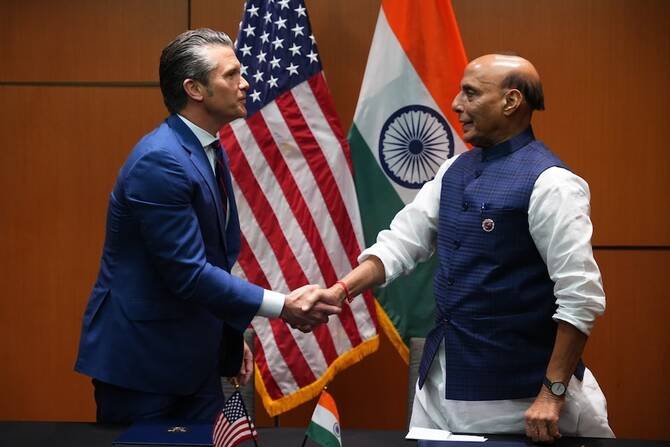In October 2025, the United States and India agreed to a 10-year defense partnership, which is an attempt at renewing defense relations between the two countries. The partnership has developed from past defense collaboration agreements between the US and India; including defense exercises, technology exchanges, and manufacturing capability. While the partnership received considerable media attention, it represents evolutionary rather than revolutionary progress.
The partnership is a result of a long-standing history of similar defense partnerships, and does not represent a paradigm shift in defense ties. However, the nature of this defense collaboration continues to evolve concerning Pakistan and the security dynamics of South Asia. It, therefore, makes sense to examine the India-US 10-year defense partnership through three different lenses: history, specific elements, and overall implications and relevance with Chanakya’s philosophical concepts.
The United States and India have had a long-standing history of defense partnerships. This recent one is an extension of those older agreements. These partnerships began formally in 2002 under the General Security of Military Information Agreement (GSOMIA), the Communications Compatibility and Security Agreement (COMCASA), and the Logistics Exchange Memorandum of Agreement (LEMOA) up until 2024.
Recently, they renewed defense relation by signing a ten-year cooperative defense partnership that would expand the areas of cooperation to include cyber and maritime security as well. This agreement will help bring the US and Indian militaries into alignment and make their defense capabilities and strategies in line with each other.
This partnership is one of the ways through which India can move toward greater independence in its own defense efforts and create self-reliant defense industries. The goal of this effort is to encourage the development of defense systems produced domestically or developed through technology transfers from other countries and to allow India to produce and export these products globally.
The partnership also anticipates India having an upgraded technological military, being able to project maritime power more effectively, and enhancing its ability to deter aggression. The improvements in India’s military capabilities and its nuclear posture align with India’s pursuit of strategic autonomy. However, India’s evolving security environment is beginning to mirror the US security environment.
Read More: Implications of India, US Defense Framework Renewal on Regional Stability
This partnership will also help to reinforce the Quad framework as a key element of the US’ Indo-Pacific Strategy to create a free, open, and rules-based regional order. It is also anticipated that increased defense cooperation between the US and India will provide an enhanced collective deterrence against what is perceived as China’s increasing assertiveness and will enable the US and India to conduct more frequent and extensive joint naval and air exercises, such as the Malabar Exercise.
Similar to other forms of strategic wisdom that are based upon the doctrines of Chanakya, the US-India defense agreement appears to reflect the concepts of not engaging directly with an adversary, depleting an adversary’s resources and winning when the circumstances are appropriate. As such, it appears that contemporary India is employing a similar type of methodology (building alliances, establishing a defense industrial base, attaining strategic independence and then waiting until the opportunity presents itself to engage) with similar replenishment concepts (economic and diplomatic) that were outlined in Chanakya’s playbook to allow India to capitalize on a potential weakening of the enemy due to internal politics.
While this agreement does provide a framework for cooperation and addresses some of the regional security concerns, including India’s negative view of China as an aggressive actor in the Indo-Pacific, the agreement does not establish a legally-binding security arrangement, like NATO. Rather, the agreement reflects an increasing level of strategic convergence, and represents a cooperative structure of defense. Media coverage of the agreement has frequently exaggerated the significance of the agreement, while downplaying the fact that defense relationships between the US and India have existed for many years, and have had little impact on the strategic balance between the two countries.
To stabilize the region, Pakistan has to employ diplomacy, modernize its military, and avoid escalating tensions due to perceived encirclements; as well as pursue positive dialogue with India and other regional actors to decrease the chance of conflict and to build trust through confidence building measures. Moreover, Pakistan needs to increase its military capability and participate in multilateral regional diplomatic forums to counter increasing Indian influence without antagonizing them.
The US can serve as a stabilizing force to create dialogue between India and Pakistan, to balance their support of India with a commitment to regional security in South Asia, and to enhance regional cooperative mechanisms. Regional actors (China, Bangladesh, Sri Lanka, etc.,) need to develop new policies to maintain an equilibrium in South Asia and not to take action that could exacerbate existing regional tensions due to competing alliances.
In a nutshell, this agreement will be a foundation for increased cooperation between our two countries toward enhancing regional stability and the overall security of the Indo-Pacific region. The degree to which this defense agreement has the ability to positively contribute to the strategic stability of South Asia depends on successful implementation of its provisions and the degree to which the United States and India can work with other regional states to address new emerging challenges as they arise.
*The views expressed in this article are the authors’ own and do not represent TDI. The contributor is responsible for the originality of this piece.

Harsa Kakar
Harsa Kakar is an Assistant Research Fellow at Balochistan Think Tank Network (BTTN), Quetta. The views expressed are personal. She can be reached at kakarhsa01@gmail.com



